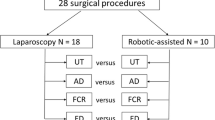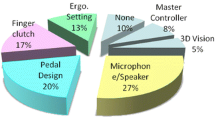Abstract
Robotic surgery has revolutionized surgical procedures and has provided many advantages over traditional laparoscopic and open surgeries. Despite the benefits, there are concerns about the physical discomfort and injuries that may be experienced by surgeons during robotic surgeries. This study aimed to identify the most common muscle groups implicated in robotic surgeons’ physical pain and discomfort. A questionnaire was created and sent to 1000 robotic surgeons worldwide, with a response rate of 30.9%. The questionnaire consisted of thirty-seven multiple-choice questions, three short answer questions, and one multiple-option question pertaining to the surgeon’s workload as well as their level of discomfort while and after performing surgery. The primary endpoint was to identify the most common muscle groups implicated in robotic surgeons’ physical pain and discomfort. Secondary endpoints were to highlight any correlation between age group, BMI, hours of operation, workout regimen, and significant pain levels. The results showed that the most common muscle groups implicated in physical pain and discomfort were the neck, shoulders, and back, with many of the surgeons attributing their muscular fatigue and discomfort to the ergonomic design of the surgeon console. Despite the level of surgeon comfort the robotic console provides when compared to other conventional forms of surgery, the findings suggest the need for better ergonomic practices during robotic surgeries to minimize physical discomfort and injuries for surgeons.






Similar content being viewed by others
References
Thai MT, Phan PT, Hoang TT, Wong S, Lovell NH, Do TN (2020) Advanced intelligent systems for surgical robotics. Adv Intell Syst 2(8):1900138. https://doi.org/10.1002/aisy.201900138
Lee GI, Lee MR, Green I, Allaf M, Marohn MR (2017) Surgeons’ physical discomfort and symptoms during robotic surgery: a comprehensive ergonomic survey study. Surg Endosc 31(4):1697–1706. https://doi.org/10.1007/s00464-016-5160-y
Nguyen NT, Ho HS, Smith WD et al (2001) An ergonomic evaluation of surgeons’ axial skeletal and upper extremity movements during laparoscopic and open surgery. Am J Surg 182(6):720–724. https://doi.org/10.1016/S0002-9610(01)00801-7
Dalager T, Søgaard K, Bech KT, Mogensen O, Jensen PT (2017) Musculoskeletal pain among surgeons performing minimally invasive surgery: a systematic review. Surg Endosc 31(2):516–526. https://doi.org/10.1007/s00464-016-5020-9
Cheng SC, Chao YK (2022) Editorial perspective: robot-assisted evaluation of robotic surgical skills. Ann Surg Oncol 29(11):6524–6525. https://doi.org/10.1245/s10434-022-12062-6
AlSabah S, Al Haddad E, Khwaja H (2019) The prevalence of musculoskeletal injuries in bariatric surgeons. Surg Endosc 33(6):1818–1827. https://doi.org/10.1007/s00464-018-6460-1
Lee GI, Lee MR, Clanton T, Sutton E, Park AE, Marohn MR (2014) Comparative assessment of physical and cognitive ergonomics associated with robotic and traditional laparoscopic surgeries. Surg Endosc 28(2):456–465. https://doi.org/10.1007/s00464-013-3213-z
Craven R, Franasiak J, Mosaly P, Gehrig PA (2013) Ergonomic deficits in robotic gynecologic oncology surgery: a need for intervention. J Minim Invasive Gynecol 20(5):648–655. https://doi.org/10.1016/j.jmig.2013.04.008
McDonald ME, Ramirez PT, Munsell MF et al (2014) Physician pain and discomfort during minimally invasive gynecologic cancer surgery. Gynecol Oncol 134(2):243–247. https://doi.org/10.1016/j.ygyno.2014.05.019
Dalager T, Jensen PT, Winther TS et al (2019) Surgeons’ muscle load during robotic-assisted laparoscopy performed with a regular office chair and the preferred of two ergonomic chairs: a pilot study. Appl Ergon 78:286–292. https://doi.org/10.1016/j.apergo.2018.03.016
Plerhoples TA, Hernandez-Boussard T, Wren SM (2012) The aching surgeon: a survey of physical discomfort and symptoms following open, laparoscopic, and robotic surgery. J Robot Surg 6(1):65–72. https://doi.org/10.1007/s11701-011-0330-3
Franasiak J, Craven R, Mosaly P, Gehrig PA (2014) Feasibility and acceptance of a robotic surgery ergonomic training program. JSLS 18(4):e2014.00166. https://doi.org/10.4293/JSLS.2014.00166
Wee IJY, Kuo L, Ngu JC (2020) A systematic review of the true benefit of robotic surgery: ergonomics. Int J Med Robot. https://doi.org/10.1002/rcs.2113
Funding
The authors have not disclosed any funding.
Author information
Authors and Affiliations
Contributions
Ela Patel and Anya Mascarenhas questionnaire design and manuscript writing Shady saikali manuscript writing and supervision of questionnaire Marcio Moschovas and Vipul Patel review of paper, questionnaire and professional opinion.
Corresponding author
Ethics declarations
Conflict of interest
The authors declare no competing interests.
Additional information
Publisher's Note
Springer Nature remains neutral with regard to jurisdictional claims in published maps and institutional affiliations.
Rights and permissions
Springer Nature or its licensor (e.g. a society or other partner) holds exclusive rights to this article under a publishing agreement with the author(s) or other rightsholder(s); author self-archiving of the accepted manuscript version of this article is solely governed by the terms of such publishing agreement and applicable law.
About this article
Cite this article
Patel, E., Saikali, S., Mascarenhas, A. et al. Muscle fatigue and physical discomfort reported by surgeons performing robotic-assisted surgery: a multinational survey. J Robotic Surg 17, 2009–2018 (2023). https://doi.org/10.1007/s11701-023-01608-9
Received:
Accepted:
Published:
Issue Date:
DOI: https://doi.org/10.1007/s11701-023-01608-9




